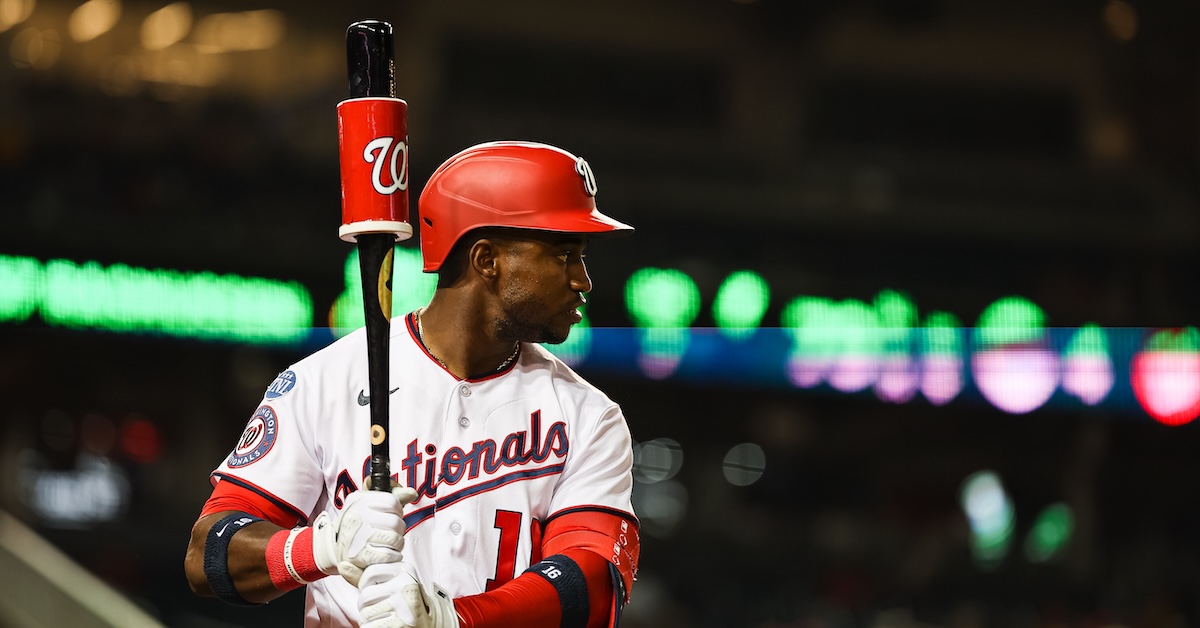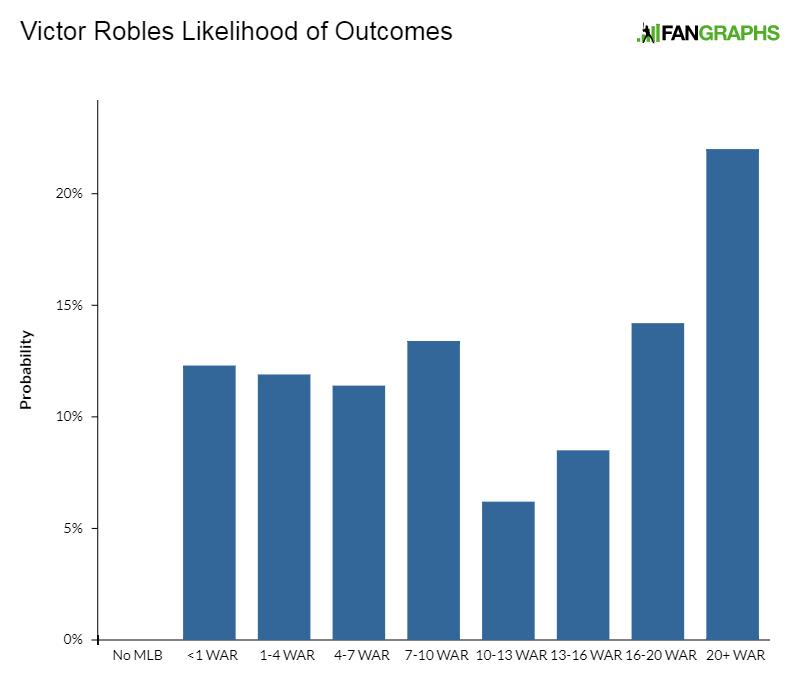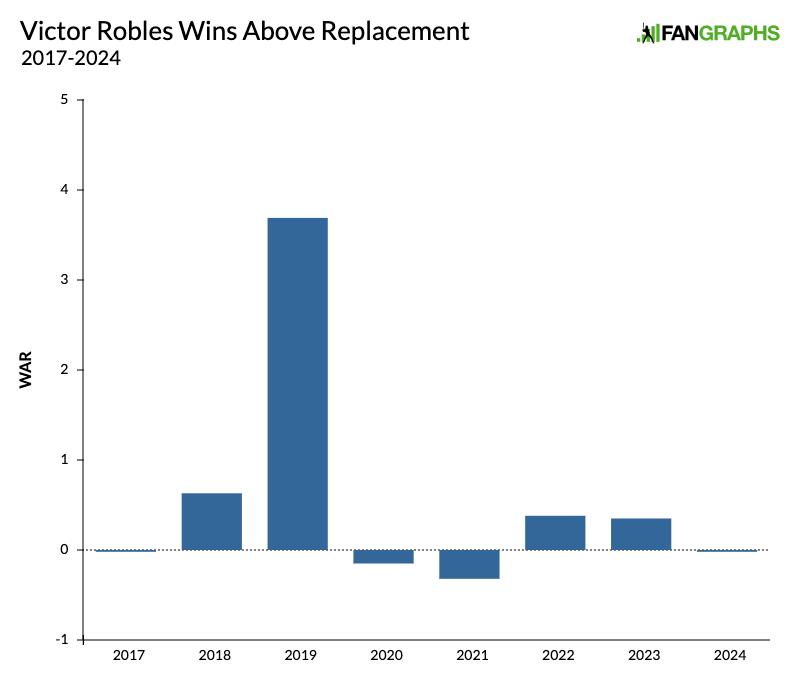
Scott Taetsch-USA TODAY Sports
It’s the double-R that makes it tricky. In the name Victor Robles, all of the emphasis is front-loaded. Victor is spondaic and Robles is trochaic, which means three stressed syllables in a row followed by that one last unstressed syllable: VIC-TOR RO-bles. It’s a shout followed by a whisper, which doesn’t exactly roll off the tongue. But even if you cheat a little bit and turn the first name into a trochee — VIC-tor RO-bles, sing-songy like Mickey Mantle or Dr Pepper — you still can’t get it to flow because you need to pause between those two Rs, lest the two names get pressed together into one breathless pileup of syllables: victorrobles. No matter what you try, that emphatic start grinds to a halt.
After more than 10 years and nearly as many false starts, the center fielder’s time with the Washington Nationals has come to a complete stop. The team designated Robles for assignment on Monday, eight days after his 27th birthday. They now have a week to trade, waive, outright, or release him. Robles, who is in his eighth season as a big leaguer, would almost certainly opt for free agency rather than accept an outright assignment to the minors. Despite his struggles, he seems likely to garner another opportunity. To Washington fans who had been dreaming on him since 2015, Robles often seemed tantalizingly close to finally breaking out. Over the course of his career, Robles has a combined .725 OPS in his first 10 games of a season and a combined .576 OPS in his last 10. He has a career 93 wRC+ in March and April; May is the only other month when he’s within 10 points of that mark. Many of those hot starts were also marred by early-season injuries: a hyper-extended elbow in April 2018, a sprained ankle in May 2021, back spasms in May 2023, a strained hamstring this April. He just never found a way to keep it going.
Robles started with a bang, putting up an .891 OPS as a 17-year-old in the 2014 Dominican Summer League after signing for just $225,000 in 2013. Jarret Seidler called him a “a nothing signing who showed up stateside with a bunch of polished potential 7 tools.” Robles first appeared in these pages in January 2015, when Kiley McDaniel said that those tools and an advanced approach at the plate might allow him to shoot up Washington’s prospect rankings. He did just that, ranking third on the 2016 team list, then first in 2017 and 2018, peaking at fourth overall that year. There was a time when it was reasonable to wonder whether you’d rather build a franchise around Robles or Ronald Acuña Jr. The graph below is from September of 2017, when the median projection from KATOH+ had Robles at 12.5 WAR in his first six years:

It was supposed to be Robles, not Juan Soto, who led the next generation of Nationals stars, but after a cup of coffee in 2017, things came to their first halt in April 2018. That’s when Robles hyper-extended his elbow and Soto got called up to Washington, never to sniff the minor leagues (or second billing) again. Robles got another cup of coffee in September, then spent all of 2019 with the big club, putting up 3.7 WAR and finishing sixth in NL Rookie of the Year voting.
To that point, Robles had been worth 4.3 WAR in 189 big league games, putting up a 96 wRC+ that seemed to promise a bright future. It looked like the one question in all those glowing scouting reports — whether he’d ever be able to tap into some power — had finally been answered. After reaching 10 homers in a season just once in the minors, he launched 17 as a 22-year-old in 2019. His defense was every bit as good as advertised; his 21 OAA was fourth-best in baseball, his 23 DRS sixth. However, there were worries lurking beneath those numbers. Batted ball luck was propping them up, and his walk rate was miles lower than it had been in the minors. Before the 2019 season, JJ Cooper noted his concerningly low exit velocities, and Robles indeed put up a big league-worst 83.3-mph average exit velocity that year.
They call batting lines like those unsustainable for a reason. The once precocious approach and feel for contact failed to hold up at the highest level; Robles posted a 15.7% strikeout rate in the minors, but a 23.3% rate in the majors. Not only did he fail to grow into any power, he finished in the first percentile in exit velocity four years in a row. As far as it’s possible to tell from the outside, he seemed to be putting in the work. In 2020, he put on 15 pounds of muscle in order to increase his power output. When the extra weight instead resulted in a loss of speed, he slimmed back down at the team’s request and worked on shortening his swing and being quick to the ball. Since 2020, Robles has a wRC+ of 70, which makes him the fifth-worst hitter in baseball over that stretch (minimum 1,000 PAs). The pizzicato brilliance of the 2019 season stands out starkly. Over parts of eight seasons, Robles has been worth 4.6 WAR, putting up 24.8 defensive runs, 6.6 baserunning runs, and -44.7 runs at the plate. If you remove 2019, his WAR drops to 0.86:

For fans who’d been reading glowing scouting reports since his teenage years, it was hard to stop dreaming on Robles. Instead, those dreams grew less and less fantastical over time. When he was a prospect, he looked like he could be the face of the franchise. After his production cratered, he looked like he could still be a solid, glove-first center fielder. Last season, Washington fans hoped merely that he could be one of the few league-average players on a cellar-bound team. Over a short sample of 36 games, Robles offered hope that he might be improving his plate discipline and making more contact, but back spasms sent him to the IL in May, then ended his season in June. This season, he suffered a hamstring strain after just four games, and when he returned, he put up a wRC+ of 10 over 10 games. The occasional mental error, formerly chalked up to the exuberance of youth, started to grate. With Lane Thomas returning from the IL, there was no longer room for Robles.
As with any top prospect who doesn’t quite pan out, we’re left wondering how to assign blame. Did Robles fail to live up to his promise, did the team’s player development fail to cultivate it, or were we wrong about that promise in the first place? The answers to those questions are hard to separate, especially with his career not yet concluded. Washington’s player development has been lagging for some time now. Scouting has changed significantly in the last 10 years, and if Robles were to appear as a prospect again today, he’d likely be ranked a bit lower.
There’s something darkly comedic about the fact that failing to develop is what allowed Robles to stick around for so long, while Soto’s ascent into superstardom made him too valuable to remain on a rebuilding and suddenly cost-conscious Nationals team. It’s only now, with Robles making $2.65 million in his walk year — fifth-highest on the team, compared to Jacob Young’s league-minimum salary — and with Washington starting to believe that they’re nearing contention, that patience has finally run out. Robles finally lost his spot to Thomas, whose career got off to a slow start before he put up a 3.1-win season in, you guessed it, his age-27 season. We’ll find out soon whether Robles is traded, waived, or simply released, and which team wants their shot at finally getting — and keeping — him going.
Source
https://blogs.fangraphs.com/waiting-for-victor-robles/
 Backyard GrillingWeekend WarriorsAdvice from DadBeard GroomingTV Shows for Guys4x4 Off-Road CarsMens FashionSports NewsAncient Archeology World NewsPrivacy PolicyTerms And Conditions
Backyard GrillingWeekend WarriorsAdvice from DadBeard GroomingTV Shows for Guys4x4 Off-Road CarsMens FashionSports NewsAncient Archeology World NewsPrivacy PolicyTerms And Conditions
